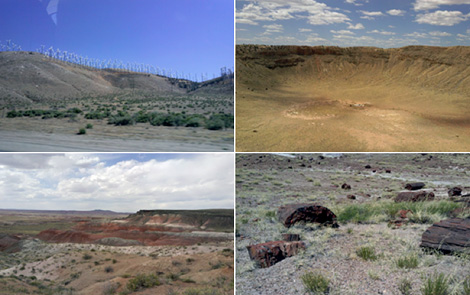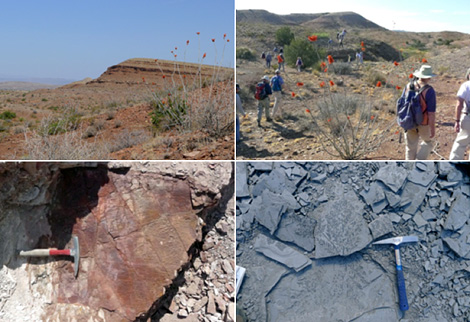Why New Mexico? Like someone else put it “it ain’t new and it sure ain’t Mexico!” So why make the trek? To attend the Carboniferous-Permian Transition Meeting! Five members of the Looy Lab piled into a van and drove all the way from Berkeley to Albuquerque. With the enormous number of meetings and conferences being organized, why did we decide to go to this particular one?
I think there is a checklist that most people go over before they decide on which conference to attend. In random order:
- Is the topic of the conference relevant (or at least a session of it)?
- Can I afford the conference fees?
- Will this gathering allow me to collaborate with some of the other attendees?
- Are there going to be other people attending that I desperately would like to talk to (but then end up being too shy to actually do so)?
- Is it in a cool location and does it offer any interesting field trips?
- Will I have something new to present by the time the conference rolls around (or do I dust off some older material)
- Is this the real conference I’m signing up for, or a bogus one where some fraud takes my money and disappears into the sunset? I am not kidding, this actually happens!
- Will I have time to prepare for the meeting and will I have time to actually attend it?
- How much does it cost to get there? Can I find a grant that covers the costs of travel?
These are all things to consider. If the answers to the questions above are ‘yes,’ or at least positive, then the conference might be worth going to. And that is how we ended up in Albuquerque. Because the conference included two field trips on which we were hoping to collect a lot of fossils, and there were five of us going to the same conference, it made sense to drive. A nice bonus was that we got to see some cool field sites along the way.

After two days of driving we arrived in Albuquerque. The conference was held at the New Mexico Museum of Natural History and Science. The conference room itself was as boring as any other conference room, but during the breaks and the banquet we got to wander around in the museum, which was really nice. It is definitely worth a visit if you’re ever in Albuquerque.
The first day of the conference was mostly about stratigraphic issues. Where is the Carboniferous-Permian boundary exactly? Do we base this on findings in Russia, China or perhaps the U.S.? There was definitely quite a bit of disagreement on that particular topic. More applied research was discussed the second day and on the third day, Wednesday, it was our turn. Cindy Looy talked about branch abscission, Robert Stevenson showed us cool movie clips of auto-rotating winged seeds, Jeff Benca discussed patterns of leaf margins and what that does and does not tell us, and I talked about phytoliths. We all got great responses. Sometimes audiences can look like they’re about to go into hibernation, but not this time. They were engaged and had good questions and recommendations for all four of us.

We also got to go on two fieldtrips. The first one was to the Kinney Brick Quarry where sediments from the Pennsylvanian, the “younger” half of the Carboniferous, crop out. The locality is considered to be a Lagerstätte, an extremely fossiliferous site with excellent preservation. On another trip, they took us east of Socorro, where the Upper Carboniferous and Lower Permian deposits are exposed along the eastern margin of the Rio Grande rift. This gave us the opportunity to collect a lot of plant fossils. We collected more than six big boxes of material. It will take a while to work our way through all of it, but that won’t stop us from collecting more fossils in the meantime. Once paleobotanists are on a roll, nothing will stop them. Not even The Thing, unfortunately.